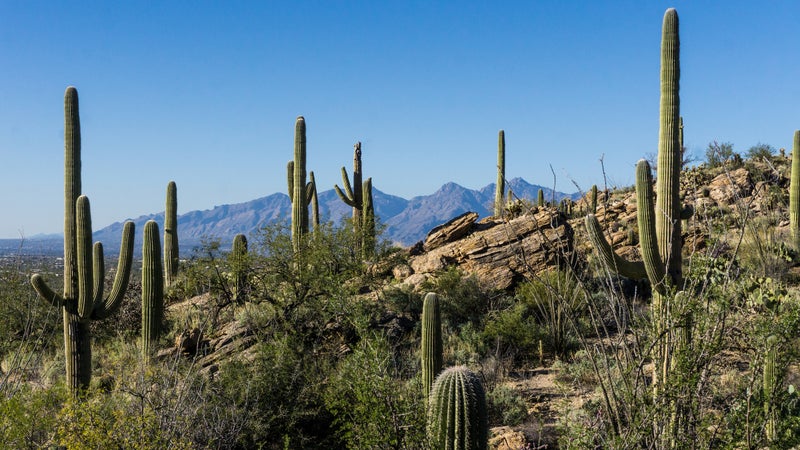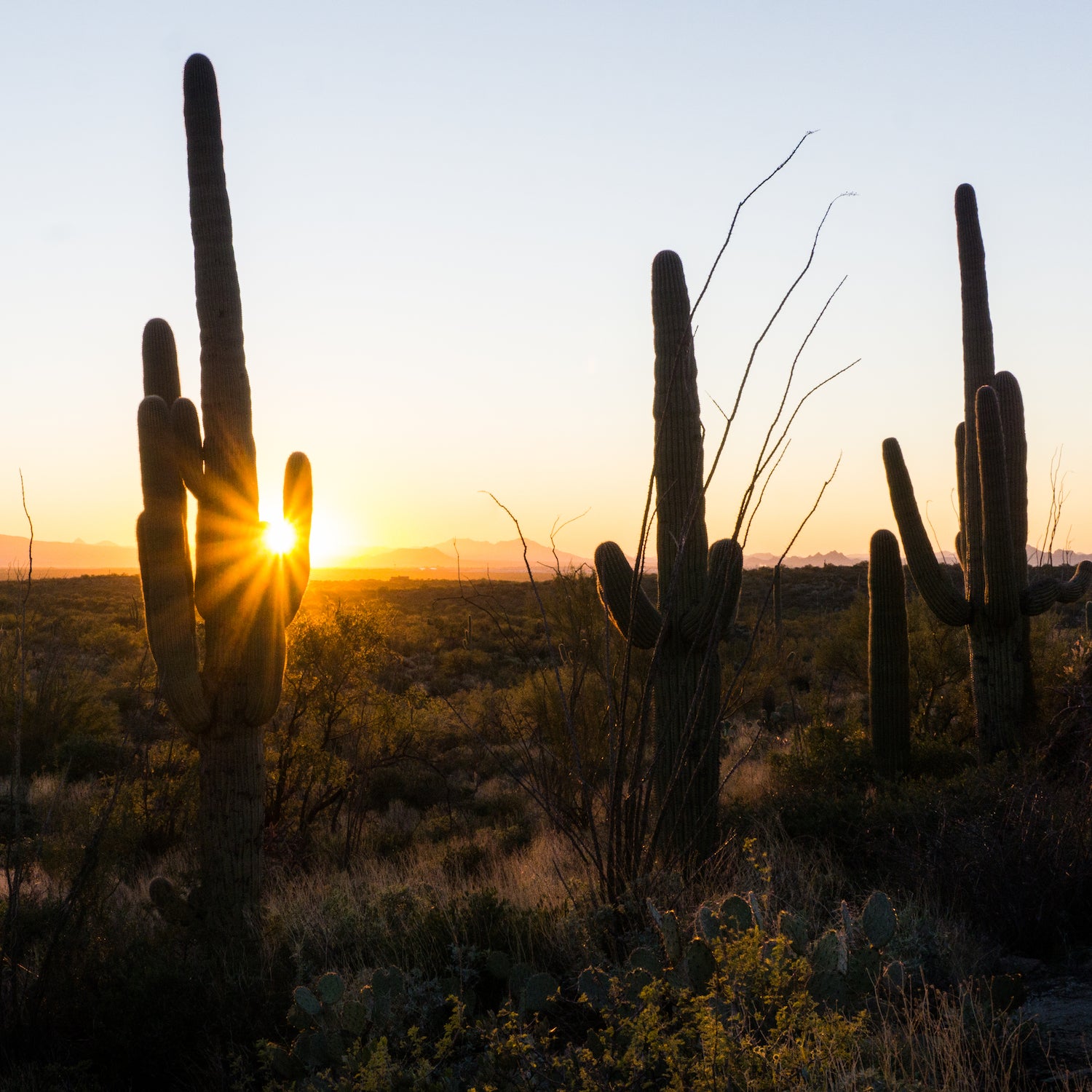62 Parks Traveler┬ástarted with a simple goal: to visit every U.S. national park in one year. Avid backpacker and public-lands nerd┬á┬ásaved up, built out a tiny van to travel and live in, and hit the road. The parks as we know them are rapidly changing, and she┬áwanted to see them before itÔÇÖs too late.
Since it was winter, I thought hiking in the desert would be easyÔÇöwith moderate temperatures and lower elevations. After years of heart-pumping┬áhigh-altitude adventures in the Sierra Nevada, I wandered onto the Tanque Verde Ridge Trail, in the eastern section of Saguaro National Park, expecting to cruise up the seven miles to 5,962-foot┬áJuniper Basin in a flash and then skip merrily down the path back to my van. How wrong I was.
The trail that leads up Tanque Verde Ridge is a must-see for any serious hiker visiting Saguaro National Park, and for good reason. ItÔÇÖs steep, rugged, and full of the parkÔÇÖs namesake cacti. But┬ámore importantly, the trail traverses a distinct series of biotic communities, from desert scrub┬áto desert grassland┬áto pine-oak woodland. I was astonished by the diversity of cacti and plant life that seemed to flourish, even at the parkÔÇÖs lowest and driest elevations.
The saguaros were everywhere. Thousands of 30-foot-tall┬ágreen pillars with nubby arms that begged to be anthropomorphized. No matter where I looked, my brain couldnÔÇÖt help but turn the centuries-old saguaros into a veritable freak show of desert cartoons. There was a sassy lady with her prickly arms at her hips, an emerald strongman showing off his biceps, and a towering mint skyscraper full of carefully carved┬áprewar bird apartments.
Just four miles into the hike, my thighs were on fire and my fair Scandinavian skin was begging for a spot of shade. It was only 65 degrees, but the sun was relentless, and I had long passed the turnaround point for most visitors. I had done my share of desert wandering, and it was time for me to navigate my way back to a beer and a burrito. At the 5.5-mile mark, I decided I had seen enough panoramic views of downtown Tucson, 15 miles from the park, and called it quits to go take in the sunset at Javelina Rocks.
On day two, I swore I wouldnÔÇÖt subject my legs to another strenuous hike, so I opted for a mellow detour to the . More zoo and botanical garden than museum, it features┬áexhibits so thoughtfully constructed that they made even a zoo skeptic like me smile. Friendly volunteer docents were easy to find and eager to help, and every last one of them recommended the ÔÇöan educational show about the regionÔÇÖs birds of preyÔÇöso thatÔÇÖs exactly where I went. I ducked for cover and squealed with childish glee amid┬áa group of silver-haired retirees every time a hawk or horned owl buzzed over our heads.
By the time I made it to the parkÔÇÖs western visitor center, it was already afternoon. I ambled up to a senior ranger at the info desk and asked what the gem of the parkÔÇÖs western district was. ÔÇťWell, did you stop to see the Desert Museum?ÔÇŁ he asked. ÔÇťThatÔÇÖs just about the best thing you could have done. It would take a lifetime to see that many animals out here while hiking.ÔÇŁ I felt like I was acing my homework.
He pointed me in the direction of the Valley View Overlook Trail for prime sunset photos. I hopped back into my van and took off down the dusty dirt road. I dodged formidable cholla and prickly pear cacti in the faint glow of the dying light, trying to capture the perfect silhouette of a mature saguaro, their strange bodies forming menacing shadow puppets against the darkening sky.
Sometimes trips are palindromes of themselves, beginning and ending in the same way or with the same emotion. I felt that in the vast Sonoran Desert, craning my neck skyward to marvel at the enormous cacti. They are bizarre and cartoonish, yes, but they are also beautiful. Timeless. Centuries-old totems of desert wisdom.

62 Parks Traveler Saguaro Info
Size: 91,716 acres
Location: Southeastern Arizona, with west and east sections that straddle Tucson
Created In: 1933 (national monument), 1994 (national park)
Best For: Hiking, backpacking, wildflower viewing, and scenic drives
When to Go: Visit in the spring (46 to 91 degrees), fall (46 to 95 degrees), or winter (39 to 69 degrees). Avoid it in summer, when average highs hover around 100 degrees.
Where to Stay: While no vehicle camping is available inside the parkÔÇÖs boundaries, Saguaro offers six backcountry camping options (permit required;┬áobtain one at the visitor center). is the largest, offering a high-elevation retreat from scorching desert temps and a perennial water source.
Where to Eat: ┬áin Tucson is the oldest family-run Mexican restaurant in the country. The eateryÔÇÖs original matriarch claims to have invented the chimichanga, and whether or not thatÔÇÖs true, they do a great job of satiating hiker hunger.
Mini ║┌┴¤│ď╣¤═°: The ,┬áin SaguaroÔÇÖs eastern Rincon Mountain District, is an eight-mile┬ápaved roadway full of breathtaking views and easy pullouts to nab that perfect sunset shot. Be sure to stop at the .25-mile accessible, interpretive┬á on the northern rim of the drive.
Mega ║┌┴¤│ď╣¤═°: Bag a peak! is the highest point in SaguaroÔÇÖs western Tucson Mountain District and worth the effort of the eight-mile loop trail to get there. Start at the King Canyon Trailhead, then hike up the wash. Be sure to look for ancient petroglyphs near the dam. Take in some incredible views from the summit before looping downhill on the saguaro-lined Hugh Norris Trail. Cap it all off with a downhill jaunt past historic Gould Mine.
Worth a Detour: The ,┬ánear the parkÔÇÖs west entrance, is a great side trip for families and animal lovers looking to learn more about the flora and fauna of the region. Highlights include the hummingbird atrium, raptor flight, and desert loop trail. And, I didnÔÇÖt have time to go, but , near the┬áparkÔÇÖs eastern section, is home to unique rock formations and a butterfly garden.


